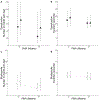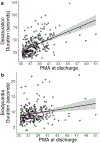Recovery from bradycardia and desaturation events at 32 weeks corrected age and NICU length of stay: an indicator of physiologic resilience?
- PMID: 31272102
- PMCID: PMC6851471
- DOI: 10.1038/s41390-019-0488-3
Recovery from bradycardia and desaturation events at 32 weeks corrected age and NICU length of stay: an indicator of physiologic resilience?
Erratum in
-
Correction: Recovery from bradycardia and desaturation events at 32 weeks corrected age and NICU length of stay: an indicator of physiologic resilience?Pediatr Res. 2020 Nov;88(5):821. doi: 10.1038/s41390-020-0822-9. Pediatr Res. 2020. PMID: 32139902
Abstract
Background: Preterm very low birth weight (VLBW) infants experience physiologic maturation and transitions off therapies from 32 to 35 weeks postmenstrual age (PMA), which may impact episodic bradycardia and oxygen desaturation. We sought to characterize bradycardias and desaturations from 32 to 35 weeks PMA and test whether events at 32 weeks PMA are associated with NICU length of stay.
Methods: For 265 VLBW infants from 32 to 35 weeks PMA, we quantified the number and duration of bradycardias (HR <100 for ≥4 s) and desaturations (SpO2 <80% for ≥10 s) and compared events around discontinuation of CPAP, caffeine, and supplemental oxygen. We modeled associations between clinical variables, bradycardias and desaturations at 32 weeks PMA, and discharge PMA.
Results: Desaturations decreased from 60 to 41 per day at 32 and 35 weeks, respectively (p < 0.01). Duration of desaturations and number and duration of bradycardias decreased to a smaller extent (p < 0.05), and there was a non-significant trend toward increased desaturations after stopping CPAP and caffeine. Controlling for clinical variables, longer duration of bradycardias and desaturations at 32 weeks PMA was associated with later discharge PMA.
Conclusion: Delayed recovery from bradycardias and desaturations at 32 weeks PMA, perhaps reflecting less physiologic resilience, is associated with prolonged NICU stay for VLBW infants.
Conflict of interest statement
Conflicts/disclosures related to this work: none
Figures



Similar articles
-
Oxygen desaturations in the early neonatal period predict development of bronchopulmonary dysplasia.Pediatr Res. 2019 Jun;85(7):987-993. doi: 10.1038/s41390-018-0223-5. Epub 2018 Oct 29. Pediatr Res. 2019. PMID: 30374050 Free PMC article.
-
Vital sign metrics of VLBW infants in three NICUs: implications for predictive algorithms.Pediatr Res. 2021 Jul;90(1):125-130. doi: 10.1038/s41390-021-01428-3. Epub 2021 Mar 25. Pediatr Res. 2021. PMID: 33767372 Free PMC article.
-
Tachycardia-Desaturation Episodes in Neonatal Intensive Care Unit Patients with and without Bronchopulmonary Dysplasia.Am J Perinatol. 2025 May;42(7):868-876. doi: 10.1055/a-2437-0461. Epub 2024 Oct 9. Am J Perinatol. 2025. PMID: 39384297
-
When does prone sleeping improve cardiorespiratory status in preterm infants in the NICU?Sleep. 2020 Apr 15;43(4):zsz256. doi: 10.1093/sleep/zsz256. Sleep. 2020. PMID: 31691829
-
Early NICU discharge of very low birth weight infants: a critical review and analysis.Semin Neonatol. 2003 Apr;8(2):95-115. doi: 10.1016/S1084-2756(02)00219-1. Semin Neonatol. 2003. PMID: 15001147 Review.
Cited by
-
Association between Intermittent Hypoxemia and NICU Length of Stay in Preterm Infants.Neonatology. 2024;121(3):327-335. doi: 10.1159/000535264. Epub 2024 Mar 4. Neonatology. 2024. PMID: 38437802 Free PMC article.
-
The relationship between intermittent hypoxemia events and neural outcomes in neonates.Exp Neurol. 2021 Aug;342:113753. doi: 10.1016/j.expneurol.2021.113753. Epub 2021 May 10. Exp Neurol. 2021. PMID: 33984336 Free PMC article. Review.
-
A novel non-invasive method of measuring microcirculatory perfusion and blood velocity in infants: a pilot study.Sci Rep. 2022 May 6;12(1):7459. doi: 10.1038/s41598-022-10911-8. Sci Rep. 2022. PMID: 35523975 Free PMC article.
-
Maturation of cardioventilatory physiological trajectories in extremely preterm infants.Pediatr Res. 2024 Mar;95(4):1060-1069. doi: 10.1038/s41390-023-02839-0. Epub 2023 Oct 19. Pediatr Res. 2024. PMID: 37857848 Free PMC article.
References
-
- Martin RJ, DiFiore JM Di, Macfarlane PM, Wilson CG. Physiologic basis for intermittent hypoxic episodes in preterm infants. Adv Exp Med Biol. 2012;758:351–8. - PubMed
-
- Eichenwald EC, Aina A, Stark AR. Apnea frequently persists beyond term gestation in infants delivered at 24 to 28 weeks. Pediatrics. 1997. September 1;100(3):354–9. - PubMed
MeSH terms
Grants and funding
LinkOut - more resources
Full Text Sources

